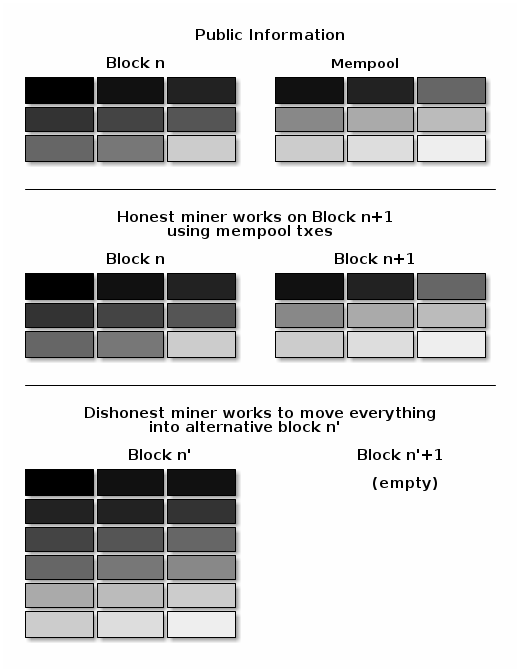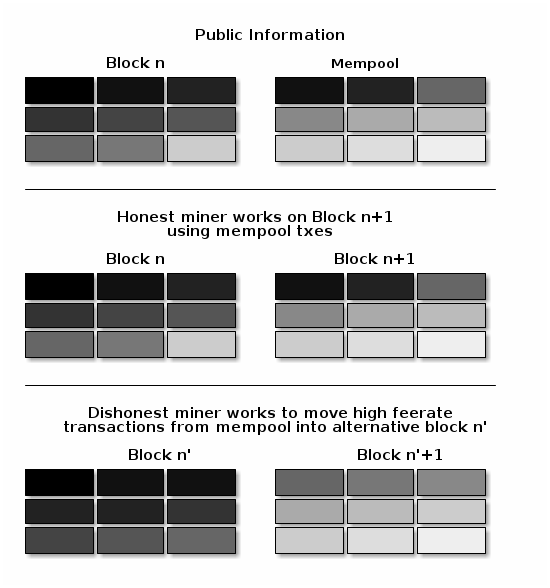Fee sniping
Also covering Anti fee sniping
Fee sniping occurs when a miner deliberately re-mines one or more previous blocks in order to take the fees from the miners who originally created those blocks. Although re-mining a previous block is less likely to succeed than simply extending the chain with a new block, it can be more profitable if the previous block is worth much more in transaction fees than the transactions currently in the miner’s mempool.
Fee sniping is a problem that may occur as Bitcoin’s subsidy
continues to diminish and transaction fees begin to dominate
Bitcoin’s block rewards. If transaction fees are all that matter,
then a miner with x percent of the hash rate has a x percent
chance of mining the next block, so the expected value to them of
honestly mining is x percent of the best feerate set of
transactions in their mempool.
Alternatively, a miner could dishonestly attempt to re-mine the
previous block plus a wholly new block to extend the
chain. This behavior is referred to as fee sniping, and the dishonest
miner’s chance of succeeding at it if every
other miner is honest is (x/(1-x))^2. Even though fee sniping has an
overall lower probability of success than honest mining, attempting
dishonest mining could be the more profitable choice if transactions in
the previous block paid significantly higher feerates than the
transactions currently in the mempool—a small chance at a large amount
can be worth more than a large chance at a small amount.
The problem is actually worse than described above because every miner who chooses to mine dishonestly reduces the number of honest miners trying to extend the chain. The smaller the share of hash rate controlled by honest miners, the greater the probability that a dishonest miner will be successful, so a single large miner rationally choosing to mine dishonestly can set off a cascade of ever smaller miners also rationally defecting to dishonest mining. If that persists for an extended period of time, confirmation scores cease to be a proxy for transaction finality and Bitcoin becomes unusable until the problem is resolved. We expect the most likely resolution would be centralization of mining—a cartel representing a majority of hash rate agreeing to never reorg each others’ blocks can restore stability to the system, but that comes with the increased risk that they’ll later censor certain transactions.
Mitigations
-
● Block transaction limit: without a limit on the number of transactions that can be contained within a block, such as a block size or block weight limit, dishonest miners could take all the transactions they know about now and try to put them into the oldest block they’re working to re-mine. All other blocks would be empty, with miners only creating them to bury their re-mined block under as much proof of work as possible.

Limiting the number of transactions that can be contained within a Bitcoin block produces two desirable effects:
-
It tends to prevent any new block at the tip of the chain from containing all pending transactions, leaving some transactions for the next block. If the amount of transaction fee expected from honestly mining the next block is close to the amount of transaction fee available from dishonestly re-mining the previous block, all rational miners will behave honestly.
-
It ensures that, even if dishonest miners do re-mine blocks, they won’t be able to achieve maximum revenue by leaving the blocks near the tip empty—those blocks will need to contain fee-paying transactions. Other dishonest miners may attempt themselves to fee snipe those transactions, reducing the revenue of the initial fee sniping miner and possibly discouraging them from fee sniping in the first place.
-
-
● Rearrangement protection (anti fee sniping): even with a block size limit, a dishonest miner doesn’t need to use the exact same set of transactions included in the block that they’re attempting to re-mine. They can replace any low feerate transactions in that block with higher feerate transactions from their mempool. This has the benefit of burying higher feerate transactions further back in the chain where other dishonest miners will have to work harder to re-mine them a second time.

It’s possible to limit this abuse by preventing miners from being able to include pending high-feerate transactions in the re-mined version of any previous block. Miners would only be allowed to include pending transactions in blocks after the current chain tip. In other words, in an ideal situation, there wouldn’t be any difference between the regular transactions in blocks created by economically rational dishonest miners and blocks created by honest miners. This can reduce the revenue available to the dishonest miner and make them more vulnerable to fee sniping by other dishonest miners—again reducing the initial dishonest miner’s expected rewards possibly enough to keep them mining honestly in the first place.
This rearrangement protection is commonly called anti fee sniping. Originally implemented in Bitcoin Core, anti fee sniping is now also used by several other wallets.
All wallets that implement anti fee sniping today use nLockTime height locks to prevent a transaction from being included in the re-mined version of a previous block. It’s also possible to implement the same protection using BIP68 nSequence height locks, which could help make regular wallet transactions look like contract protocol transactions and vice versa.
We’re unaware of any developers who think the above mechanisms are a complete solution to the fee sniping problem, but every other mitigation that has been proposed so far seems to have significant downsides. None of those alternatives appears to be an active area of research and development.
Primary code and documentation
- Bitcoin Core #2340: discourage fee sniping with nLockTime
- Anti-fee-sniping protection with nSequence in taproot transactions
Optech newsletter and website mentions
2021
2020
- C-Lightning #3465 implements anti fee sniping for withdrawal transactions
- Suggestion to use anti fee sniping for interactive LN funding transactions
2018
Previous Topic:
Erlay
Next Topic:
Generic signmessage
